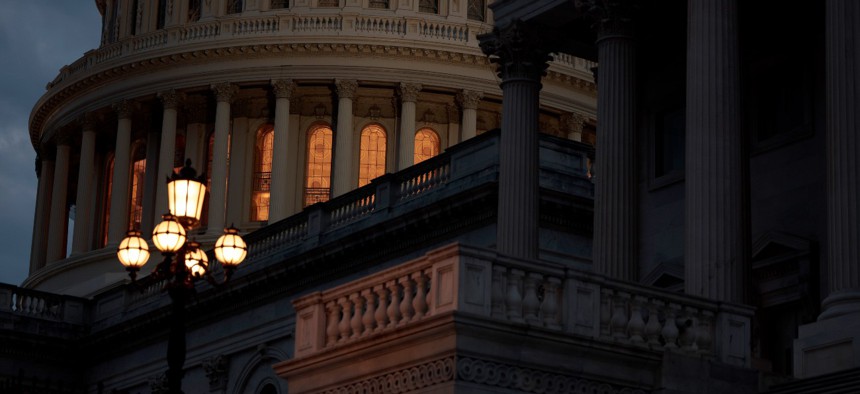What Does Another Continuing Resolution Mean for Federal Contractors?

Anna Moneymaker/Getty Images
These stopgap spending measures can lead to "endless stop-and-start contract cycles, creating inefficiency and disruption."
Members of the contracting community laid out the various workforce and operational challenges associated with short-term funding measures ahead of a Thursday night Senate vote on a continuing resolution. This latest CR – the third for fiscal 2022 – funds the government through March 11. On Friday afternoon, the White House announced that President Biden had signed it.
“Of course, ideally, a normal budget process under regular order would be ideal, as the CR carries with it certain challenges, like the cap on spending and the limitation on new starts,” Roger Waldron, president of the Coalition for Government Procurement, told Government Executive on Thursday. “Still, a CR extension provides all sides time to collaborate on a mutually beneficial spending agreement.”
“For contractors, CR challenges now are somewhat different from those in the past" because “with inflation increasing, purchasing power is diminished and contractor costs effectively increase, straining their capacity to perform without losing money,” Waldron said. “Thus, whatever CR and ultimate budget agreement is reached, addressing the impact of inflation on contracting will help keep the industrial base stable.”
The National Defense Industrial Association told Government Executive in a statement on Tuesday it understands the need for another stopgap measure and was “encouraged” that lawmakers reached an agreement on a framework and topline numbers for fiscal 2022.
The association “look[s] forward to get funding for fiscal year 2022 as soon as possible to support our warfighters and the defense industrial base that provides them with the capabilities and innovations to stay ahead,” said the statement. “At nearly five months into the fiscal year, we cannot afford any additional delays.”
The association, along with the Professional Services Council––which represents over 400 companies that do business with the federal government–– and nine other trade associations, sent a letter to congressional letters on Jan. 11 urging them to finalize all 12 full-year appropriations bills for fiscal 2022 before the Feb. 18 deadline. They also agreed with the concerns raised by Defense Secretary Lloyd Austin III in December about a full-year continuing resolution.
One of the impacts of a continuing resolution is that “defense industry workforces are subject to seemingly endless stop-and-start contract cycles, creating inefficiency and disruption that ripples through the defense supply chain with disproportionate effects on smaller companies,” said the letter shared with Government Executive. “We appreciate your time and attention to this request and look forward to working with you to reduce the harmful impacts of continuing resolutions on federal agencies and the contractors who support agency missions.”
With a continuing resolution “a real issue that we have to look at not only on contractors, but on government operations itself, you know, the one we know most about is no new starts and its corollary, which is no stopping of anything old, which is often just as wasteful as not starting the new things, real dampening effect on innovation, technology advancement, and so on,” David Berteau, PSC president and CEO, told Federal Drive last month. “But I think there’s a far more insidious impact, and that is the impact on delaying contract awards, even if the funding is available from prior year appropriations or under the continuing resolution.”
During a briefing on Wednesday, White House Press Secretary Jen Psaki was asked when Biden will send his budget proposal for fiscal 2023 to Congress. Psaki said she didn’t have a date, but noted that Shalanda Young, acting director of the Office of Management and Budget, recently told lawmakers it would come after the State of the Union, which is March 1.
Update: This article was updated to reflect Biden signing the continuing resolution at 2:54 p.m.
NEXT STORY: Protest hits CIO-SP4 on proposal deadline day


